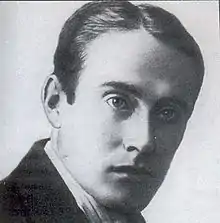Aleksandr Nikolayev (painter)
Aleksandr Vasilievich Nikolayev (Russian: Алекса́ндр Васи́льевич Никола́ев; 30 August 1897 – 27 June 1957), also known as Usto Mumin (Russian: Усто́ Муми́н), was a Soviet painter of Russian origin, who lived and worked in the Uzbek SSR.
Aleksandr Nikolayev | |
|---|---|
 Aleksandr Nikolayev (Usto Mumin) | |
| Born | Aleksandr Vasilievich Nikolayev 30 August 1897 |
| Died | 27 June 1957 (aged 59) |
| Nationality | Soviet |
| Known for | Painting |
| Movement | Soviet avant-garde |
Biography
.jpg.webp)
Early years
Alexander Nikolayev was born in Voronezh in 1897. His father was a military engineer, who traveled extensively around Russian Empire, taking the family with him, before settling permanently in Voronezh in 1914. Nikolayev studied in the Sumsk Military School from 1908 till 1916. There he met his first painting teacher Nikolay Evlampiev. After military school he served in Imperial Russian Army in 1916–1917. After army studied in Uhlan School in Tver till 1918, when he started to attend the art studio of Alexander Buchkuri in Voronezh. He began to study in the Second State Free Art Studio in Moscow in 1919 under Kazimir Malevich. Shortly after the beginning of his studies he was drafted to Red Army and sent to the front.[1]
Central Asia
Nikolayev was sent to Tashkent after demobilization in 1920. His mission was to develop art and culture in new Soviet Central Asia and work closely with Turkestan Central Executive Committee. Nikolayev felt in love with Central Asia. The local culture and traditions started to influence and inspire his life and art. There is a legend that said Alexander Nikolayev converted to Islam, which cannot be supported by any official documents because of persecution of religion by Soviet authorities after revolution.[2] He received a new name from his pupils - Usto Mumin, which means "Faithful and Gentle Master".[3]
Arrest and imprisonment
He was working as a director of Uzbek Pavilion at Union Agricultural Exhibition in Moscow, when he was unexpectedly arrested and imprisoned.[4] One of the reasons for his arrest was his homosexuality.[5] Many of his works, painted in his early Uzbek period had homoerotic themes and used Bacha bazi as a subject. One of his most well-known paintings "Pomegranate Zeal", which is in the iconographic tradition, tells the story of two young boys from the moment they meet until their death.[6][7] He spent four years in prison and was released in 1942. He wasn't allowed to paint while in prison.
Later years
After release, Nikolaev returned to Uzbekistan and continued to work as illustrator and theatre designer. He received a Honorary Award from the Central Executive Committee of Uzbek Soviet Socialist Republic for his role in establishing the Uighur Theatre in Tashkent. Alexander Nikolayev died in Tashkent in 1957.
Exhibitions and collections
Usto Mumin's works are in collections of museums in post USSR countries, including State Museum of Oriental Art in Moscow, Nukus Museum of Art and Museum of Arts of Uzbekistan.[8] He exhibited throughout USSR during his lifetime, including exhibition "Old Samarkand" in Samarkand in 1924, Jubilee Exhibition of Soviet Art in Moscow in 1927 and several exhibitions in Tashkent. Tretyakov Gallery exhibited works of Usto Mumin in 2010 as part of Russian Orientalist paintings exhibition.[9]
Notable exhibitions
- 1935. "Exhibition of Six". Curated by Fedor Shmit. Museum of Arts of Uzbekistan, Tashkent[10]
- 2006. "Ecstasy of Usto Mumin". Ilkhom Theatre gallery. Tashkent[11]
- 2013. "Echo of Vanguard". Ilkhom Theatre gallery. Tashkent[12]
- 2017. "Retrospective of XX century Uzbek art". Uzbekistan Academy of Arts. Tashkent[13]
In modern culture
Tashkent theatre Ilkhom created a project "Pomegranate Zeal" after Usto Mumin. It is a play combined with an exhibition of Usto Mumin's paintings.[14]
References
- Shafranskaya, Eleonora (2014). "Chapter 2: Before Samarkand". A.V. Nikolayev - Usto Mumin: destiny in history and culture (in Russian). Saint Petersburg: Svoe Izdatelstvo. pp. 15–17. ISBN 978-5-4386-0334-4.
- "Usto Mumin: truth or myth". vesti.uz.
- "Nikolayev Alexander (Usto-Mumin)". The Karakalpak State Art Museum.
- Marinika Babanazarova. "Feature: Savitsky and the Uzbek School of Art". Steppe Magazine.
- "Art books: Usto Mumin and Alexander Volkov". uzbekjourneys.com.
- "Usto Mumin: Pomegranate Zeal". gender-route.org.
- "Usto Mumin". vesti.uz.
- "The collection of works of the fine arts of Uzbekistan". Museum of Arts of Uzbekistan.
- "Russia's Artistic Orientalist History". Tretyakov Gallery Magazine. 18 February 2016.
- Chuhovich, Boris. "The museum stories of Usto Mumin". gazeta.uz.
- "В Ташкенте открылась уникальная выставка работ Усто Мумина". Ferghana News. Retrieved 2018-04-30.
- Yeremyan, Rimma (2013-02-07). "Usto Mumin in the Echo of Vanguard". San'aat. Retrieved 2018-04-30.
- "Узбекистан: В Ташкенте открывается ретроспективная выставка художников-юбиляров". Retrieved 2018-04-30.
- "Pomegranate Zeal premiere in Ilhom". fergananews.com.